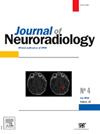脑中动脉闭塞位置对急性缺血性脑卒中伴颅内动脉粥样硬化性狭窄血管内再灌注治疗的临床影响
IF 3.3
3区 医学
Q2 CLINICAL NEUROLOGY
引用次数: 0
摘要
背景与目的本研究基于血管造影确定的大脑中动脉(MCA)闭塞位置,探讨血管内再灌注治疗和紧急颅内支架植入术的临床效果。材料和方法我们回顾了连续的急性MCA梗死合并颅内动脉粥样硬化性狭窄(ICAS)患者,这些患者在首次机械取栓后接受了颅内支架置入术和球囊血管成形术。我们比较了患者的人口统计学特征、基线特征、临床结果和围手术期并发症,包括支架内血栓形成和再闭塞,根据MCA闭塞的位置。在入组的ICAS患者中,根据MCA近端残端是否存在来分类闭塞位置。结果47例患者中30例(63.8%)为残肢组。无残肢组初始NIHSS较残肢组更严重(13.0 [8.0 - 16.0]vs. 8.0 [8.0 - 13.0] p = 0.078)。两组在手术时间、技术和设备上无显著差异。然而,无残肢组血运重建成功率明显较低(64.7% vs 100%, p = 0.002)。此外,无残端组首次血管内再灌注治疗后立即再闭塞率更高(76.5% vs 36.7%, p = 0.02)。围手术期并发症(包括脑出血)与死亡率之间无显著相关性。结论在ICAS下的急性大血管闭塞中,造影表现为无残端MCA闭塞的患者比残端患者更容易出现颅内支架置入术的并发症和更差的临床结果。本文章由计算机程序翻译,如有差异,请以英文原文为准。
Clinical impact of occlusion location in the middle cerebral artery during endovascular reperfusion therapy for acute ischemic stroke with underlying intracranial atherosclerotic stenosis
Background and Purpose
This study examines the clinical outcomes of endovascular reperfusion therapy and emergent intracranial stenting based on the angiographically defined occlusion location of the middle cerebral artery (MCA).
Materials and Methods
We reviewed consecutive patients with acute MCA infarct associated with intracranial atherosclerotic stenosis (ICAS) who underwent rescue intracranial stenting and balloon angioplasty after initial mechanical thrombectomy. We compared patient demographics, baseline characteristics, clinical outcomes, and periprocedural complications, including in-stent thrombosis and re-occlusion, according to the MCA occlusion location. The occlusion location was categorized based on the presence of the proximal MCA stump in enrolled ICAS patients.
Results
Of 47 patients, 30 (63.8 %) were classified as having a stump group. The initial NIHSS was more severe in the without-stump group compared to the with-stump group (13.0 [8.0–16.0] vs. 8.0 [8.0–13.0] p = 0.078). There were no significant differences in procedure time, technique, and devices. However, the successful revascularization rate was significantly lower in the without-stump group (64.7 % vs. 100 %, p = 0.002). Additionally, the immediate re-occlusion rate after the first endovascular reperfusion therapy tended to be higher in the without-stump group (76.5 % vs. 36.7 %, p = 0.02). No significant association was found between periprocedural complications, including intracerebral hemorrhage and mortality.
Conclusions
Angiographically presented MCA occlusion without a stump in acute large vessel occlusion underlying ICAS predicts more complicated intracranial stenting and poorer clinical outcomes than patients with a stump.
求助全文
通过发布文献求助,成功后即可免费获取论文全文。
去求助
来源期刊

Journal of Neuroradiology
医学-核医学
CiteScore
6.10
自引率
5.70%
发文量
142
审稿时长
6-12 weeks
期刊介绍:
The Journal of Neuroradiology is a peer-reviewed journal, publishing worldwide clinical and basic research in the field of diagnostic and Interventional neuroradiology, translational and molecular neuroimaging, and artificial intelligence in neuroradiology.
The Journal of Neuroradiology considers for publication articles, reviews, technical notes and letters to the editors (correspondence section), provided that the methodology and scientific content are of high quality, and that the results will have substantial clinical impact and/or physiological importance.
 求助内容:
求助内容: 应助结果提醒方式:
应助结果提醒方式:


